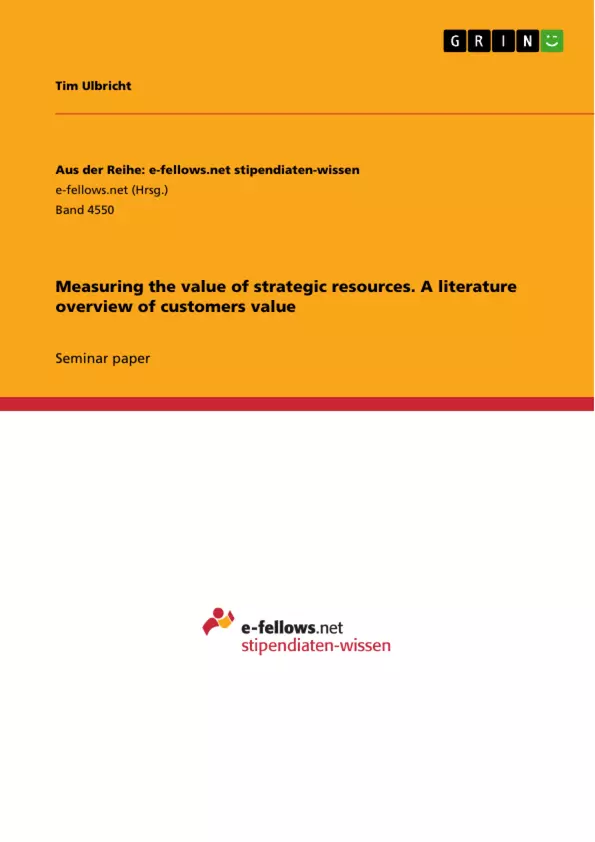This seminar paper gives an overview on the literature of measuring customer value. A lot of companies have a very low book to market value e.g. Apple (0.15), Microsoft (0.14), Amazon (0.04!) and Facebook (0.14) as of December 2017. Though according to US-GAAP and IFRS annual reports should provide investors and prospect investors with decision useful information the balance sheet lacks certain intangible assets that are obviously driving the value of the firm. That are for example brand equity, organizational capital and customer equity. Such assets became more important so that not only for researchers but also for practitioners and standard setters there is an incentive to identify possibilities to measure such assets reliably to make better investment decisions or, for the latter, to increase the decision usefulness of the information provided in the annual reports.
There is an increasing number of SBE (subscription based enterprises) or at least SB offerings which leads to an increasing number of balance sheets that do not sufficiently reflect the value of the firm. For a long time the value of customers was just a marketing issue and not in the focus of accounting researchers but due to the development described above it is getting into focus of accounting literature in the past decades (Gleaves, Burton, Kitshoff, Bates, & Whittington, 2008, pp. 827–832). There are several approaches to value customers, but they have in common that first the value of a single customer is derived the so called CLV (customer lifetime value), sometimes also referred to as CV (customer value). To value the customer base of a firm all CLVs are aggregate to derive the so-called CE (customer equity). The value a customer has for a firm is the sum of all discounted future contribution margins the firm can obtain from him (Berger & Nasr, 1998, pp. 18–19). Therefore, I first look at the eligibility of customer value as an asset. Afterwards I compare different approaches to derive the CLV then the approaches to derive the CE. Next, I analyze the literature concerning the link between performance and customer and show a possible calculation on the example of Netflix.
Inhaltsverzeichnis (Table of Contents)
- 1. Introduction
- 2. Customers as an asset?
- 3. The value of a single customer: the customer lifetime value
- 3.1 Definitions and boundaries
- 3.2 Components of customer value
- 4. The value of all customers: the customer equity
- 4.1 Definitions and boundaries
- 4.2 Measurement
- 5. Link between customer equity and profitability
- 6. A case study on customer based valuation: Netflix
Zielsetzung und Themenschwerpunkte (Objectives and Key Themes)
This seminar paper provides an overview of the literature on measuring customer value. The objective is to examine the concept of customer value as an asset and its implications for accounting and financial reporting. The paper explores different approaches to measure the customer lifetime value (CLV) and customer equity (CE), including their relationship to profitability. Furthermore, it analyzes the feasibility of valuing customers as assets based on their potential for future economic benefits.
- The significance of customer value as an asset in modern business
- The definition, components, and measurement of customer lifetime value (CLV)
- The concept of customer equity (CE) and its relationship to profitability
- The challenges and limitations of accounting for customer value
- The application of customer-based valuation in real-world contexts
Zusammenfassung der Kapitel (Chapter Summaries)
The paper begins by addressing the debate surrounding whether customers qualify as assets. It explores the International Accounting Standards Board (IASB) definition of assets and analyzes how customers potentially fit within this framework. The paper emphasizes the challenges of measuring and reporting customer value due to its intangible nature and lack of market price.
Chapter 3 delves into the concept of customer lifetime value (CLV), focusing on its definition, boundaries, and various approaches for calculating it. It highlights the complexity of this measurement and the numerous factors influencing customer value.
Chapter 4 explores the concept of customer equity (CE), which represents the aggregated CLV of all customers. The chapter examines definitions, measurement methods, and the relationship between CE and overall firm profitability. It emphasizes the importance of understanding the value of the customer base for making informed business decisions.
Schlüsselwörter (Keywords)
The paper revolves around the key terms and concepts of customer value, customer lifetime value (CLV), customer equity (CE), intangible assets, financial reporting, accounting standards, and valuation methodologies. It explores the application of these concepts in the context of subscription-based enterprises (SBE) and their implications for financial reporting and investment decisions.
- Quote paper
- Tim Ulbricht (Author), 2018, Measuring the value of strategic resources. A literature overview of customers value, Munich, GRIN Verlag, https://www.grin.com/document/415736



